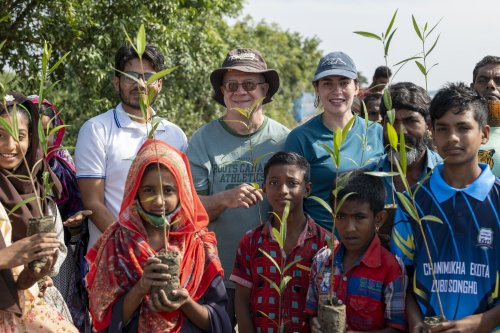
MAP Visits the Sundarbans Mangrove Forest
In December 2023, the MAP team visited the Sundarbans, the world’s largest mangrove forest, sprawling across southern Bangladesh and eastern India, covering approximately 10,000 square kilometers. The visit provided a firsthand exploration of the forest and some of the fantastic groups working to conserve and protect it.
The Sundarbans play a crucial role in protecting many vulnerable coastal people on low-lying land. The forest is a UNESCO world heritage site and is home to many endangered species, including the Bengal tiger. The Sundarbans are under considerable pressure from urban expansion from the north and the (sadly violent) shrimp mafia wanting to expand their operations within the forest. Needless to say, conservation and enforcement of protective laws are poor.
Our visit to the Sundarbans offered a firsthand look at the impactful initiatives being undertaken by local NGOs, community members and the forest department. In Bangladesh, we met with BEDS, a local NGO partner that MAP has been in contact with for several years, offering technical advice online, supporting their mangrove restoration work, and linking the NGO with local academics and funders. BEDS’ mission is to build the capacity of the most vulnerable communities to ensure the sustainable use of natural resources, provide eco-friendly means of living, and reduce the adverse effects of climate change. BEDS has been using MAP’s CBEMR technique since they started restoring mangroves in 2014, with much of this work focused in the Sundarbans.
In India, we met with NEWS, a local NGO partner that MAP has also been in contact with for several years, offering technical advice on mangrove restoration and helping to connect groups across the region. NEWS’ focus is to conserve wildlife, ecology, natural resources & sustainable livelihoods for an improved environment. Our visit enabled us to see the restoration work first-hand, witness the challenges the Indian Sundarbans are facing and strengthen and develop our relationships with other local partners.
From community mapping projects to the restoration of mangroves along the riverbanks, we witnessed the dedication of local communities to restoring the Sundarbans’ diverse ecosystem. BEDS’ emphasis on community engagement highlights their commitment to empowering local residents as the guardians of their mangroves. The success of their efforts was evident in the thriving mangrove restoration sites and the strategic use of fencing to protect young trees from grazing animals. In India, we visited many community groups including Mukti and the ‘Green Brigade’ women’s group on Lokiputchor island. The Green Brigade’s tireless efforts to restore their mangroves has led to a remarkable accomplishment, expanding the forest area from 300 hectares to over 1000 hectares. The trip culminated in an insightful workshop at CIBA in Kakdwip, highlighting the need for adaptive solutions in mangrove restoration, particularly in the face of vulnerable communities’ daily survival challenges.
Our interactions with the Mowal honey gatherers and aquaculture practitioners provided further insights into the intricate relationship between communities and the Sundarbans ecosystem. Overall, our visit with BEDS, NEWS, local community groups and government staff has deepened our understanding of sustainable mangrove restoration and environmental conservation, setting the stage for future impactful initiatives in the Sundarbans.






